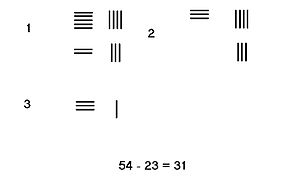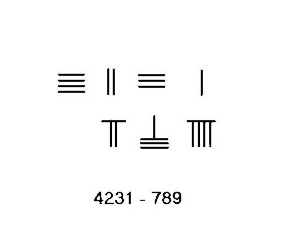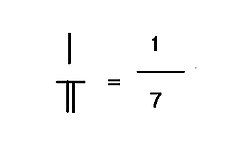|
Rod calculusRod calculus or rod calculation was the mechanical method of algorithmic computation with counting rods in China from the Warring States to Ming dynasty before the counting rods were increasingly replaced by the more convenient and faster abacus. Rod calculus played a key role in the development of Chinese mathematics to its height in the Song dynasty and Yuan dynasty, culminating in the invention of polynomial equations of up to four unknowns in the work of Zhu Shijie.   HardwareThe basic equipment for carrying out rod calculus is a bundle of counting rods and a counting board. The counting rods are usually made of bamboo sticks, about 12 cm- 15 cm in length, 2mm to 4 mm diameter, sometimes from animal bones, or ivory and jade (for well-heeled merchants). A counting board could be a table top, a wooden board with or without grid, on the floor or on sand. In 1971 Chinese archaeologists unearthed a bundle of well-preserved animal bone counting rods stored in a silk pouch from a tomb in Qian Yang county in Shanxi province, dated back to the first half of Han dynasty (206 BC – 8AD).[citation needed] In 1975 a bundle of bamboo counting rods was unearthed.[citation needed] The use of counting rods for rod calculus flourished in the Warring States, although no archaeological artefacts were found earlier than the Western Han dynasty (the first half of Han dynasty; however, archaeologists did unearth software artefacts of rod calculus dated back to the Warring States); since the rod calculus software must have gone along with rod calculus hardware, there is no doubt that rod calculus was already flourishing during the Warring States more than 2,200 years ago. SoftwareThe key software required for rod calculus was a simple 45 phrase positional decimal multiplication table used in China since antiquity, called the nine-nine table, which were learned by heart by pupils, merchants, government officials and mathematicians alike. Rod numeralsDisplaying numbers  Rod numerals is the only numeric system that uses different placement combination of a single symbol to convey any number or fraction in the Decimal System. For numbers in the units place, every vertical rod represent 1. Two vertical rods represent 2, and so on, until 5 vertical rods, which represents 5. For number between 6 and 9, a biquinary system is used, in which a horizontal bar on top of the vertical bars represent 5. The first row are the number 1 to 9 in rod numerals, and the second row is the same numbers in horizontal form. For numbers larger than 9, a decimal system is used. Rods placed one place to the left of the units place represent 10 times that number. For the hundreds place, another set of rods is placed to the left which represents 100 times of that number, and so on. As shown in the adjacent image, the number 231 is represented in rod numerals in the top row, with one rod in the units place representing 1, three rods in the tens place representing 30, and two rods in the hundreds place representing 200, with a sum of 231. When doing calculation, usually there was no grid on the surface. If rod numerals two, three, and one is placed consecutively in the vertical form, there's a possibility of it being mistaken for 51 or 24, as shown in the second and third row of the adjacent image. To avoid confusion, number in consecutive places are placed in alternating vertical and horizontal form, with the units place in vertical form,[1] as shown in the bottom row on the right.  Displaying zeroesIn Rod numerals, zeroes are represented by a space, which serves both as a number and a place holder value. Unlike in Hindu-Arabic numerals, there is no specific symbol to represent zero. Before the introduction of a written zero, in addition to a space to indicate no units, the character in the subsequent unit column would be rotated by 90°, to reduce the ambiguity of a single zero.[2] For example 107 (𝍠 𝍧) and 17 (𝍩𝍧) would be distinguished by rotation, in addition to the space, though multiple zero units could lead to ambiguity, e.g. 1007 (𝍩 𝍧), and 10007 (𝍠 𝍧). In the adjacent image, the number zero is merely represented with a space. Negative and positive numbersSong mathematicians used red to represent positive numbers and black for negative numbers. However, another way is to add a slash to the last place to show that the number is negative.[3] Decimal fractionThe Mathematical Treatise of Sunzi used decimal fraction metrology. The unit of length was 1 chi, 1 chi = 10 cun, 1 cun = 10 fen, 1 fen = 10 li, 1 li = 10 hao, 10 hao = 1 shi, 1 shi = 10 hu. 1 chi 2 cun 3 fen 4 li 5 hao 6 shi 7 hu is laid out on counting board as where Southern Song dynasty mathematician Qin Jiushao extended the use of decimal fraction beyond metrology. In his book Mathematical Treatise in Nine Sections, he formally expressed 1.1446154 day as He marked the unit with a word “日” (day) underneath it.[4] Addition Rod calculus works on the principle of addition. Unlike Arabic numerals, digits represented by counting rods have additive properties. The process of addition involves mechanically moving the rods without the need of memorising an addition table. This is the biggest difference with Arabic numerals, as one cannot mechanically put 1 and 2 together to form 3, or 2 and 3 together to form 5. The adjacent image presents the steps in adding 3748 to 289:
The rods in the augend change throughout the addition, while the rods in the addend at the bottom "disappear". Subtraction Without borrowingIn situation in which no borrowing is needed, one only needs to take the number of rods in the subtrahend from the minuend. The result of the calculation is the difference. The adjacent image shows the steps in subtracting 23 from 54.  BorrowingIn situations in which borrowing is needed such as 4231–789, one need use a more complicated procedure. The steps for this example are shown on the left.
Multiplication  Sunzi Suanjing described in detail the algorithm of multiplication. On the left are the steps to calculate 38×76:
Division    The animation on the left shows the steps for calculating 309/7 = 441/7.
The Sunzi algorithm for division was transmitted in toto by al Khwarizmi to Islamic country from Indian sources in 825AD. Al Khwarizmi's book was translated into Latin in the 13th century, The Sunzi division algorithm later evolved into Galley division in Europe. The division algorithm in Abu'l-Hasan al-Uqlidisi's 925AD book Kitab al-Fusul fi al-Hisab al-Hindi and in 11th century Kushyar ibn Labban's Principles of Hindu Reckoning were identical to Sunzu's division algorithm.  FractionsIf there is a remainder in a place value decimal rod calculus division, both the remainder and the divisor must be left in place with one on top of another. In Liu Hui's notes to Jiuzhang suanshu (2nd century BCE), the number on top is called "shi" (实), while the one at bottom is called "fa" (法). In Sunzi Suanjing, the number on top is called "zi" (子) or "fenzi" (lit., son of fraction), and the one on the bottom is called "mu" (母) or "fenmu" (lit., mother of fraction). Fenzi and Fenmu are also the modern Chinese name for numerator and denominator, respectively. As shown on the right, 1 is the numerator remainder, 7 is the denominator divisor, formed a fraction 1/7. The quotient of the division 309/7 is 44 + 1/7. Liu Hui used a lot of calculations with fractions in Haidao Suanjing. This form of fraction with numerator on top and denominator at bottom without a horizontal bar in between, was transmitted to Arabic country in an 825AD book by al Khwarizmi via India, and in use by 10th century Abu'l-Hasan al-Uqlidisi and 15th century Jamshīd al-Kāshī's work "Arithematic Key". Addition 1/3 + 2/5
Subtraction 8/9 − 1/5
Multiplication 31/3 × 52/5
Highest common factor and fraction reduction The algorithm for finding the highest common factor of two numbers and reduction of fraction was laid out in Jiuzhang suanshu. The highest common factor is found by successive division with remainders until the last two remainders are identical. The animation on the right illustrates the algorithm for finding the highest common factor of 32,450,625/59,056,400 and reduction of a fraction. In this case the hcf is 25. Divide the numerator and denominator by 25. The reduced fraction is 1,298,025/2,362,256. Interpolation Calendarist and mathematician He Chengtian (何承天) used fraction interpolation method, called "harmonisation of the divisor of the day" (调日法) to obtain a better approximate value than the old one by iteratively adding the numerators and denominators a "weaker" fraction with a "stronger fraction".[5] Zu Chongzhi's legendary π = 355/113 could be obtained with He Chengtian's method[6] System of linear equations Chapter Eight Rectangular Arrays of Jiuzhang suanshu provided an algorithm for solving System of linear equations by method of elimination:[7] Problem 8-1: Suppose we have 3 bundles of top quality cereals, 2 bundles of medium quality cereals, and a bundle of low quality cereal with accumulative weight of 39 dou. We also have 2, 3 and 1 bundles of respective cereals amounting to 34 dou; we also have 1,2 and 3 bundles of respective cereals, totaling 26 dou. Find the quantity of top, medium, and poor quality cereals. In algebra, this problem can be expressed in three system equations with three unknowns. This problem was solved in Jiuzhang suanshu with counting rods laid out on a counting board in a tabular format similar to a 3x4 matrix:
Algorithm:
The amount of one bundle of low quality cereal From which the amount of one bundle of top and medium quality cereals can be found easily:
Extraction of Square rootAlgorithm for extraction of square root was described in Jiuzhang suanshu and with minor difference in terminology in Sunzi Suanjing.   The animation shows the algorithm for rod calculus extraction of an approximation of the square root from the algorithm in chap 2 problem 19 of Sunzi Suanjing:
The algorithm is as follows:
.
North Song dynasty mathematician Jia Xian developed an additive multiplicative algorithm for square root extraction, in which he replaced the traditional "doubling" of "fang fa" by adding shang digit to fang fa digit, with same effect. Extraction of cubic root Jiuzhang suanshu vol iv "shaoguang" provided algorithm for extraction of cubic root. 〔一九〕今有積一百八十六萬八百六十七尺。問為立方幾何?答曰:一百二十三尺。 problem 19: We have a 1860867 cubic chi, what is the length of a side ? Answer:123 chi. North Song dynasty mathematician Jia Xian invented a method similar to simplified form of Horner scheme for extraction of cubic root. The animation at right shows Jia Xian's algorithm for solving problem 19 in Jiuzhang suanshu vol 4. Polynomial equation North Song dynasty mathematician Jia Xian invented Horner scheme for solving simple 4th order equation of the form South Song dynasty mathematician Qin Jiushao improved Jia Xian's Horner method to solve polynomial equation up to 10th order. The following is algorithm for solving
This equation was arranged bottom up with counting rods on counting board in tabular form
Algorithm:
Tian Yuan shu Yuan dynasty mathematician Li Zhi developed rod calculus into Tian yuan shu Example Li Zhi Ceyuan haijing vol II, problem 14 equation of one unknown:
Polynomial equations of four unknowns Mathematician Zhu Shijie further developed rod calculus to include polynomial equations of 2 to four unknowns. For example, polynomials of three unknowns: Equation 1: Equation 2: Equation 3: After successive elimination of two unknowns, the polynomial equations of three unknowns was reduced to a polynomial equation of one unknown:
Solved x=5; Which ignores 3 other answers, 2 are repeated. See alsoReferences
|




![{\displaystyle {\sqrt[{3}]{1860867}}=123}](https://wikimedia.org/api/rest_v1/media/math/render/svg/6b546524683588f789435df4b594458b77b8267a)











